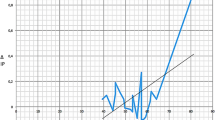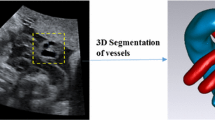Abstract
Significant reductions in blood flow and umbilical diameters were reported in pregnancies affected by intrauterine growth restriction (IUGR) from placental insufficiency. However, it is not known if IUGR umbilical blood vessels experience different hemodynamic wall shear stresses (WSS) compared to normal umbilical vessels. As WSS is known to influence vasoactivity and vascular growth and remodeling, which can regulate flow rates, it is important to study this parameter. In this study, we aim to characterize umbilical vascular WSS environment in normal and IUGR pregnancies, and evaluate correlation between WSS and vascular diameter, and gestational age. Twenty-two normal and 21 IUGR pregnancies were assessed via ultrasound between the 27th and 39th gestational week. IUGR was defined as estimated fetal weight and/or abdominal circumference below the 10th centile, with no improvement during the remainder of the pregnancy. Vascular diameter was determined by 3D ultrasound scans and image segmentation. Umbilical artery (UA) WSS was computed via computational flow simulations, while umbilical vein (UV) WSS was computed via the Poiseuille equation. Univariate multiple regression analysis was used to test for the differences between normal and IUGR cohort. UV volumetric flow rate, UA and UV diameters were significantly lower in IUGR fetuses, but flow velocities and WSS trends in UA and UV were very similar between normal and IUGR groups. In both groups, UV WSS showed a significant negative correlation with diameter, but UA WSS had no correlation with diameter, suggesting a constancy of WSS environment and the existence of WSS homeostasis in UA, but not in UV. Despite having reduced flow rate and vascular sizes, IUGR UAs had hemodynamic mechanical stress environments and trends that were similar to those in normal pregnancies. This suggested that endothelial dysfunction or abnormal mechanosensing was unlikely to be the cause of small vessels in IUGR umbilical cords.





Similar content being viewed by others
References
Acharya G, Wilsgaard T, Berntsen GK, Maltau JM, Kiserud T (2005) Reference ranges for serial measurements of umbilical artery Doppler indices in the second half of pregnancy. Am J Obstet Gynecol 192:937–944. https://doi.org/10.1016/j.ajog.2004.09.019
Adams RH et al (1999) Roles of ephrinB ligands and EphB receptors in cardiovascular development: demarcation of arterial/venous domains, vascular morphogenesis, and sprouting angiogenesis. Genes Dev 13:295–306
Adamson SL, Whiteley KJ, Langille BL (1992) Pulsatile pressure-flow relations and pulse-wave propagation in the umbilical circulation of fetal sheep. Circul Res 70:761–772
Arroyo JA, Winn VD (2008) Vasculogenesis and angiogenesis in the IUGR placenta. Semin Perinatol 32:172–177. https://doi.org/10.1053/j.semperi.2008.02.006
Arslan M, Yazici G, Erdem A, Erdem M, Ozturk Arslan E, Himmetoglu O (2004) Endothelin 1 and leptin in the pathophysiology of intrauterine growth restriction. Int J Gynecol Obstetr 84:120–126. https://doi.org/10.1016/S0020-7292(03)00332-1
Barbieri C, Cecatti JG, Surita FG, Marussi EF, Costa JV (2012) Sonographic measurement of the umbilical cord area and the diameters of its vessels during pregnancy. J Obstetr Gynaecol 32:230–236. https://doi.org/10.3109/01443615.2011.647129
Barker DJ (2006) Adult consequences of fetal growth restriction. Clin Obstet Gynecol 49:270–283
Barut F et al (2010) Intrauterine growth restriction and placental angiogenesis. Diagn Pathol 5:24. https://doi.org/10.1186/1746-1596-5-24
Boito S, Struijk PC, Ursem NTC, Stijnen T, Wladimiroff JW (2002) Umbilical venous volume flow in the normally developing and growth-restricted human fetus. Ultrasound Obstetr Gynecol 19:344–349. https://doi.org/10.1046/j.1469-0705.2002.00671.x
Burkhardt T, Matter CM, Lohmann C, Cai H, Lüscher TF, Zisch AH, Beinder E (2009) Decreased umbilical artery compliance and IGF-I plasma levels in infants with intrauterine growth restriction—implications for fetal programming of hypertension. Placenta 30:136–141. https://doi.org/10.1016/j.placenta.2008.11.005
Caniuguir A, Krause BJ, Hernandez C, Uauy R, Casanello P (2016) Markers of early endothelial dysfunction in intrauterine growth restriction-derived human umbilical vein endothelial cells revealed by 2D-DIGE and mass spectrometry analyses. Placenta 41:14–26
Casanello P, Sobrevia L (2002) Intrauterine growth retardation is associated with reduced activity and expression of the cationic amino acid transport systems y+/hCAT-1 and y+/hCAT-2B and lower activity of nitric oxide synthase in human umbilical vein endothelial cells. Circul Res 91:127–134
Clark AR, Lin M, Tawhai M, Saghian R, James JL (2015) Multiscale modelling of the feto-placental vasculature. Interface Focus 5:20140078. https://doi.org/10.1098/rsfs.2014.0078
Cosmi E, Fanelli T, Visentin S, Trevisanuto D, Zanardo V (2011) Consequences in infants that were intrauterine growth restricted. J Pregnancy https://doi.org/10.1155/2011/364381
dela Paz NG, Walshe Walshe TE, Leach LL, Saint-Geniez M, D’Amore PA (2012) Role of shear-stress-induced VEGF expression in endothelial cell survival. J Cell Sci 125:831–843
Dodson RB, Rozance PJ, Fleenor BS, Petrash CC, Shoemaker LG, Hunter KS, Ferguson VL (2013) Increased arterial stiffness and extracellular matrix reorganization in intrauterine growth-restricted fetal sheep. Pediatric Res 73:147–154. https://doi.org/10.1038/pr.2012.156
Egorova AD et al (2012) Endothelial colony-forming cells show a mature transcriptional response to shear stress. In Vitro Cell Dev Biol Anim 48:21–29
Ferrazzi E, Rigano S, Bozzo M, Bellotti M, Giovannini N, Galan H, Battaglia FC (2000) Umbilical vein blood flow in growth-restricted fetuses. Ultrasound Obstetr Gynecol 16:432–438. https://doi.org/10.1046/j.1469-0705.2000.00208.x
Flo K, Wilsgaard T, Acharya G (2010) Longitudinal reference ranges for umbilical vein blood flow at a free loop of the umbilical cord. Ultrasound Obstetr Gynecol 36:567–572. https://doi.org/10.1002/uog.7730
Georgiadis L, Keski-Nisula L, Harju M, Räisänen S, Georgiadis S, Hannila ML, Heinonen S (2014) Umbilical cord length in singleton gestations: a Finnish population-based retrospective register study. Placenta 35:275–280. https://doi.org/10.1016/j.placenta.2014.02.001
Giles WB, Trudinger BJ (1986) Umbilical cord whole blood viscosity and the umbilical artery flow velocity time waveforms: a correlation. Br J Obstetr Gynaecol 93:466–470
Hoefer IE, den Adel B, Daemen MJ (2013) Biomechanical factors as triggers of vascular growth. Cardiovasc Res 99:276–283
Hracsko Z, Hermesz E, Ferencz A, Orvos H, Novak Z, Pal A, Varga IS (2009) Endothelial nitric oxide synthase is up-regulated in the umbilical cord in pregnancies complicated with intrauterine growth retardation. In Vivo 23:727–732
Krause B, Carrasco-Wong I, Caniuguir A, Carvajal J, Farias M, Casanello P (2013) Endothelial eNOS/arginase imbalance contributes to vascular dysfunction in IUGR umbilical and placental vessels. Placenta 34:20–28
Kutner MH, Nachtsheim C, Neter J (2008) Applied linear regression models. vol Book, Whole, 4th international edn. McGraw-Hill, New York
Lai CQ, Lim GL, Jamil M, Mattar CN, Biswas A, Yap CH (2016) Fluid mechanics of blood flow in human fetal left ventricles based on patient-specific 4D ultrasound scans. Biomech Model Mechanobiol 15:1159–1172. https://doi.org/10.1007/s10237-015-0750-5
Lausman A, McCarthy FP, Walker M, Kingdom J (2012) Screening, diagnosis, and management of intrauterine growth restriction. JOGC 34:17–28
Lu D, Kassab GS (2011) Role of shear stress and stretch in vascular mechanobiology. J R Soc Interface 8:1379–1385. https://doi.org/10.1098/rsif.2011.0177
Myatt L (1992) Control of vascular resistance in the human placenta. Placenta 13:329–341. https://doi.org/10.1016/0143-4004(92)90057-Z
Nelson DM, Johnson RD, Smith SD, Anteby EY, Sadovsky Y (1999) Hypoxia limits differentiation and up-regulates expression and activity of prostaglandin H synthase 2 in cultured trophoblast from term human placenta. Am J Obstet Gynecol 180:896–902
ÖStlund EVA, Lindholm H, Hemsen A, Fried G (2000) Fetal erythropoietin and endothelin-1: relation to hypoxia and intrauterine growth retardation. Acta Obstetr Gynecol Scand 79:276–282. https://doi.org/10.1034/j.1600-0412.2000.079004276.x
Rashdan NA, Lloyd PG (2015) Fluid shear stress upregulates placental growth factor in the vessel wall via NADPH oxidase 4. Am J Physiol Heart Circul Physiol 309:H1655–H1666
Rigano S, Bozzo M, Ferrazzi E, Bellotti M, Battaglia FC, Galan HL (2001) Early and persistent reduction in umbilical vein blood flow in the growth-restricted fetus: a longitudinal study. Am J Obstet Gynecol 185:834–838. https://doi.org/10.1067/mob.2001.117356
Rutherford RA, McCarthy A, Sullivan MH, Elder MG, Polak JM, Wharton J (1995) Nitric oxide synthase in human placenta and umbilical cord from normal, intrauterine growth-retarded and pre-eclamptic pregnancies. Br J Pharmacol 116:3099–3109
Saw SN, Dawn C, Biswas A, Mattar CNZ, Yap CH (2017) Characterization of the in vivo wall shear stress environment of human fetus umbilical arteries and veins. Biomech Model Mechanobiol 16:197–211
Shore VH, Wang TH, Wang CL, Torry RJ, Caudle MR, Torry DS (1997) Vascular endothelial growth factor, placenta growth factor and their receptors in isolated human trophoblast. Placenta 18:657–665. https://doi.org/10.1016/S0143-4004(97)90007-2
Strong TH Jr, Jarles DL, Vega JS, Feldman DB (1994) The umbilical coiling index. Am J Obstetr Gynecol 170:29–32. https://doi.org/10.1016/S0002-9378(94)70378-7
Struijk PC, Mathews VJ, Loupas T, Stewart PA, Clark EB, Steegers EA, Wladimiroff JW (2008) Blood pressure estimation in the human fetal descending aorta. Ultrasound Obstetr Gynecol 32:673–681. https://doi.org/10.1002/uog.6137
Struijk PC, Stewart PA, Fernando KL, Mathews VJ, Loupas T, Steegers EAP, Wladimiroff JW (2005) Wall shear stress and related hemodynamic parameters in the fetal descending aorta derived from color Doppler velocity profiles. Ultrasound Med Biol 31:1441–1450. https://doi.org/10.1016/j.ultrasmedbio.2005.07.006
Tchirikov M, Rybakowski C, Hüneke B, Schoder V, Schröder H (2002) Umbilical vein blood volume flow rate and umbilical artery pulsatility as ‘venous-arterial index’in the prediction of neonatal compromise. Ultrasound obstetr Gynecol 20:580–585
Thorburn J, Drummond MM, Whtgham KA, Lowe GDO, Forbes CD, Prentice CRM, Whitfield CR (1982) Blood viscosity and haemostatic factors in late pregnancy, pre-eclampsia and fetal growth retardation. BJOG 89:117–122. https://doi.org/10.1111/j.1471-0528.1982.tb04676.x
Vandenbosche RC, Kirchner JT (1998) Intrauterine growth retardation. Am Fam Physician 58(1384–1390):1393-1384
Wallner W, Sengenberger R, Strick R, Strissel Pamela L, Meurer B, Beckmann Matthias W, Schlembach D (2007) Angiogenic growth factors in maternal and fetal serum in pregnancies complicated by intrauterine growth restriction. Clin Sci 112:51–57. https://doi.org/10.1042/cs20060161
Wang HU, Chen ZF, Anderson DJ (1998) Molecular distinction and angiogenic interaction between embryonic arteries and veins revealed by ephrin-B2 and its receptor Eph-B4. Cell 93:741–753
Wiputra H et al (2016a) Fluid mechanics of human fetal right ventricles from image-based computational fluid dynamics using 4D clinical ultrasound scans. Am J Physiol Heart Circul Physiol 311:H1498–h1508. https://doi.org/10.1152/ajpheart.00400.2016
Wiputra H, Lim GL, Chia DAK, Mattar CNZ, Biswas A, Yap CH (2016b) Methods for fluid dynamics simulations of human fetal cardiac chambers based on patient-specific 4D ultrasound scans. J Biomech Sci Eng https://doi.org/10.1299/jbse.15-00608
Yap CH, Liu X, Pekkan K (2014) Characterizaton of the vessel geometry, flow mechanics and wall shear stress in the great arteries of wildtype prenatal mouse. PLoS ONE 9:e868878
Acknowledgements
This study was supported by the Singapore Ministry of Education Academic Research Funding Tier 1 entitled “Placenta Blood Oxygen Monitor for Intrauterine Growth Restriction Pregnancies" (PI: Yap).
Funding
The Singapore Ministry of Education Academic Research Funding Tier 1 Grant (2016, PI: Yap, Choon Hwai)
Author information
Authors and Affiliations
Corresponding author
Ethics declarations
Conflict of interest
The authors report no conflict of interest.
Additional information
Publisher's Note
Springer Nature remains neutral with regard to jurisdictional claims in published maps and institutional affiliations.
Electronic supplementary material
Below is the link to the electronic supplementary material.
Rights and permissions
About this article
Cite this article
Saw, S.N., Poh, Y.W., Chia, D. et al. Characterization of the hemodynamic wall shear stresses in human umbilical vessels from normal and intrauterine growth restricted pregnancies. Biomech Model Mechanobiol 17, 1107–1117 (2018). https://doi.org/10.1007/s10237-018-1017-8
Received:
Accepted:
Published:
Issue Date:
DOI: https://doi.org/10.1007/s10237-018-1017-8




